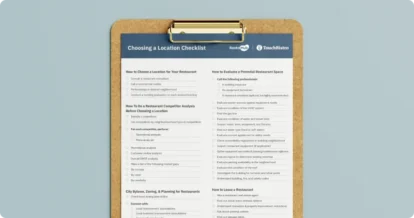When it comes to opening a restaurant, few decisions are as critical as choosing the right location. The perfect spot can set you up for success, while the wrong one could leave your restaurant struggling to attract customers. We’ve created this restaurant location strategy checklist to help you make informed decisions and avoid common pitfalls during your search for the perfect space.
Share your contact info for instant access to the checklist, or keep reading to learn more about choosing a venue for your business.
What is a Restaurant Location Strategy?
A restaurant location strategy is all about finding the perfect place to set up shop. It’s not just about picking a space that looks good; it’s a deliberate process that considers your concept, target market, foot traffic, competitors, and city regulations.
The goal? To position your restaurant in a spot where it can thrive, attract the right customers, and remain sustainable for the long term.
Why is Location Important for a Restaurant?
If you want to know why location is important for restaurants, you’ve come to the right place. Location really is everything for restaurants. It impacts not just your visibility, but also your customer base, marketing efforts, and overall success:
- Customer demographics: Your location can dictate who your customers will be so it’s important to pick the right spot for your concept. A location analysis example might find that a downtown location attracts professionals looking for quick lunches or upscale spots for after-work drinks or meals with clients. A suburban location, on the other hand, might draw families looking for full-service dining or casual takeout options.
- Foot traffic: Restaurants in high-traffic areas often serve as their own billboards. While these spots can come with higher rent, built-in visibility can reduce advertising expenses. Low-traffic locations may save you on rent, but require more effort (and money) to draw customers in.
- Parking matters: In places where driving is the norm, having accessible parking can be a game-changer. Without it, customers may look elsewhere for convenience.
What You’ll Learn From This Restaurant Location Strategy Checklist
Our business location analysis checklist breaks down all of the essential steps to help you find and secure the ideal venue for your restaurant. Here’s a sneak peek at what you’ll find when you download our free restaurant location strategy checklist:
How to Choose the Best Location for a Restaurant Business
- Talk to a restaurant consultant: They can provide expert insights into what makes a location viable for your concept.
- Call a commercial realtor: A realtor experienced in restaurant spaces can help you find locations that meet your needs and budget.
How to Conduct a Competitor Restaurant Location Analysis
- Identify competitors: Research similar restaurants near potential locations.
- Do a restaurant SWOT analysis: Evaluate competitors’ strengths, weaknesses, opportunities, and threats to see how you can differentiate yourself as part of your restaurant site selection analysis.
Familiarize Yourself with City Bylaws, Zoning, and Planning Rules
- Check local zoning laws online: Ensure the area permits your restaurant type (ex: fast casual, full service, brewery, etc.).
- Engage with the community: Connect with relevant community groups and associations to understand potential restrictions or opportunities.
How to Evaluate a Potential Restaurant Space
- Assess the space: Ensure the layout fits your concept and operations.
- Call in the experts: Have professionals inspect the property’s HVAC system, plumbing, and structural condition.
How to Lease a Restaurant Space
- Understand lease terms: Know the limitations on renovations and improvements.
- Clarify landlord responsibilities: Determine who’s responsible for maintenance, utilities, and property updates.
Finding the perfect location is a mix of art and science, but with the right tools, you can make it easier. Download our Rrestaurant Llocation Sstrategy Cchecklist today and set your restaurant up for a long and financially viable future from day one.
